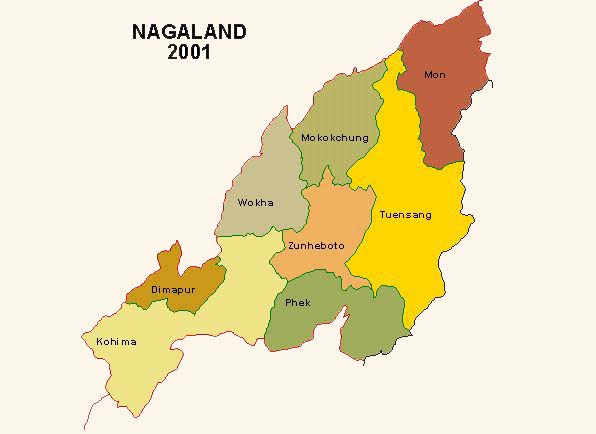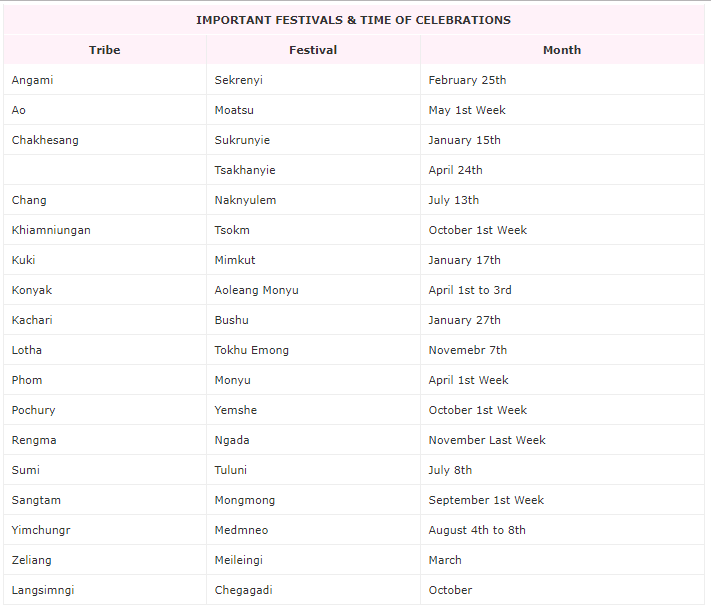Nagaland – State’s information – important facts 28/05/2019 – Posted in: STATE SERIES – Tags: Meghalaya, Telangana
NAGALAND
Nagaland is a land of festivals. The State of Nagaland was formally inaugurated on December 1st, 1963, as the 16th State of the Indian Union.
| Capital | Kohima |
| Date of Formation | December 1st, 1963 |
| State Border | Assam, Arunachal Pradesh, Manipur |
| International Border | Myanmar (Burma) |
| Number of Districts | 11 |
| Languages | Nagamese, Cerole, Assamese, English |
| State Animal | Mithun |
| State Bird | Blyth’s Tragopan |
| State Tree | Alder |
| State Flower | Kopou |
| Tribes | Angami, Khiamniungan, Lotha, Sumi, Ao, Kuki, Phom, Sangtam, Chakhesang, Konyak, Pochury, Yimchungr, Chang, Kachari, Rengma, Zeliang |
| Sanctuaries, National Park and Zoological Parks | Nagaland Zoological Park, Fakim Wildlife Sanctuary, Singphan Wildlife Sanctuary, Intanki National |
| Minerals | Coal, limestone, nickel, cobalt, chromium, magnetite, copper, zinc, and recently discovered platinum, petroleum and natural gas are the major minerals available in Nagaland. |
Songs
It is a land of folklore passed down the generations through word of mouth. Here, music is an integral part of life; folk songs eulogising ancestors, the brave deeds of warriors and traditional heroes; poetic love songs immortalising ancient tragic love stories; Gospel songs that touch your soul (should you have a religious bend of mind) or the modern tunes rendered exquisitely to set your feet a-tapping.
Hornbill Festival
A 21st century creation of Nagaland is the Hornbill festival, an event which is now getting known globally. During Hornbill, which takes place on the first week of December, the entire Naga culture is showcased in full splendor in the Kisama village of Kohima district. The government of Nagaland welcomes one and all to this mega event for a preview of what the state has to offer in terms of culture, traditions, tourism interest and industry.
Festivals
Spirits, fertility, social bonding and purification are the key elements that form the essence of the Naga festivals – the custom that each tribe follows, translates into a festival. These traditional events, combined with life in the rural areas, are exceptionally engaging and distinctive.
Flora and Fauna
- The varieties of the native flowering flora are countless in Nagaland. Orchids & Rhododendrons can be found everywhere.
- Bamboo also have great cultural and economical value.
- In Nagaland, bamboo provides the body and the soul for traditional architecture, crafts and tools, besides being the state’s major commercial produce for paper and textile industries.
- The merits of this wonder grass can be seen in Asia’s largest bamboo pavilion that the Govt. of Nagaland has built in Kisama (the site of the hornbill festival in Kohima district).
Facts
- The rare Blyth’s tragopan (Tragopan blythii) is a resident of Nagaland.
- Amur falcons (Falco amurensis) was discovered in Nagaland.
- Nagaland has a single-chamber Legislative Assembly with 60 seats.
- There are seven local government administrative districts.
- Nagaland used to be a union territory before 1963.
- The other interesting information about Nagaland is that it houses as many as 16 different ethnic groups. These groups of people have their own separate cultural identities which include customs, dresses and languages.
You can follow us on LinkedIn and for more updates related to UPSC IAS Preparation, Like our Facebook Page and subscribe our Diligent IAS Youtube Channel
Also read more about other Indian States


